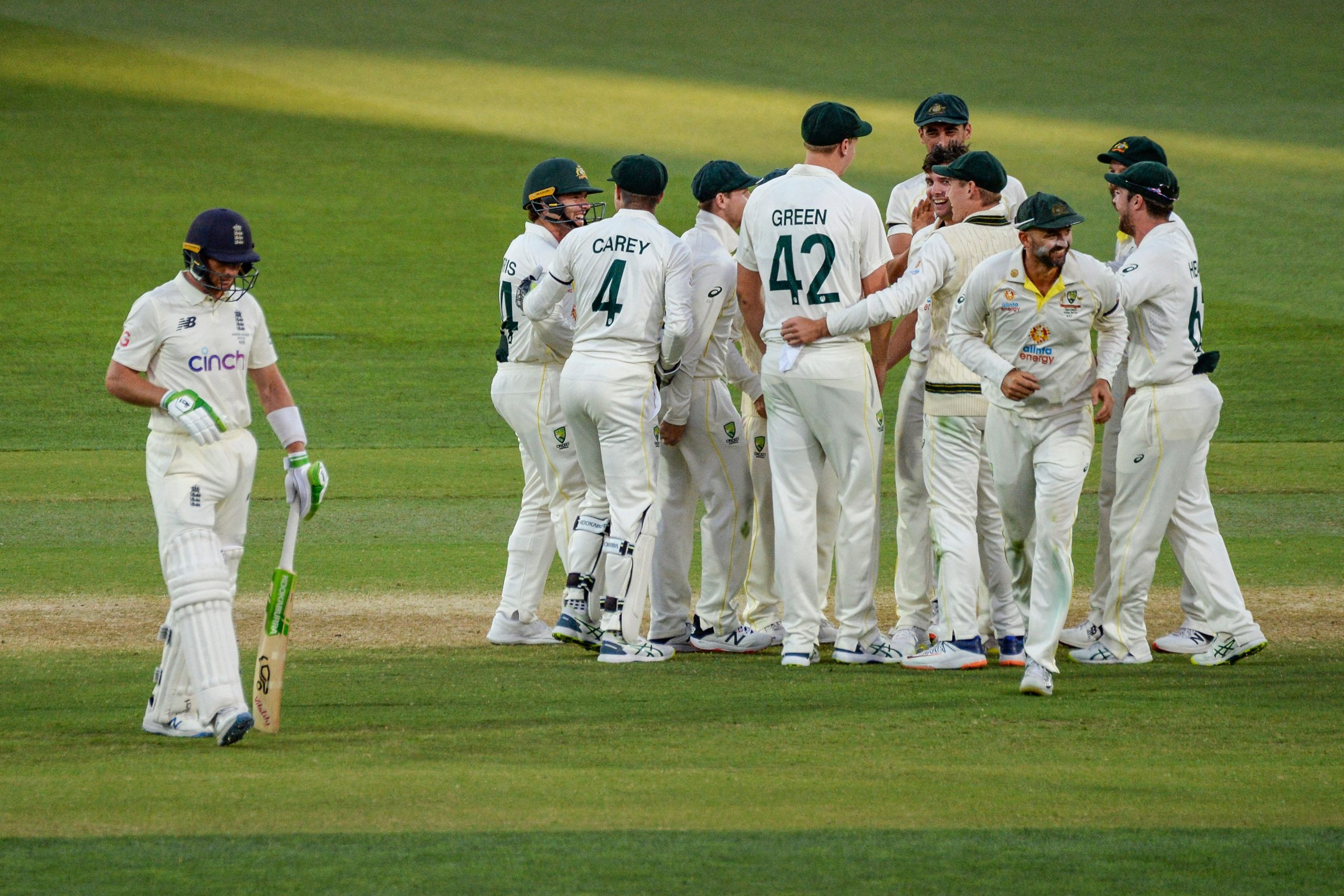Welcome to The Data Day, our rolling Ashes stats blog for 2021-22. Here, we use data to try and make sense of what just happened and why. And when we can’t, we ask our models what they think.
December 20, Day 5
England 192 // Australia win by 275 runs
Well, if they take nothing else from this Test – and to be honest, there’s not a lot of positives coming out of Adelaide – at least England can say they made Australia work for their win. Starting the day on 82-4, it was always going to be a mammoth task for England to bat the overs needed to salvage an unlikely draw. So unlikely in fact that our Live Win Probability model gave them just a 4% chance of doing so after stumps yesterday.
England scrapped and fought hard, and it was perhaps a surprise that it took Australia as long as it did to finally seal victory, after Jhye Richardson had James Anderson caught in the slips in the evening session.
England scored their 192 off 113.1 overs: to put that into perspective, since 2011 that was their fourth-longest fourth innings in terms of overs faced.
The resistance started with Stokes, who bunkered down to make 12 off 77 balls. His strike rate of 15.6 was his lowest ever in a Test innings in which he’s faced at least 20 deliveries.
After Ollie Pope’s troubles continued, Stokes was joined by Jos Buttler. Buttler has had a turbulent tour, combining moments of magic behind the stumps with inexplicable lapses in concentration. His gritty 22 lasted 207 balls, and his strike rate (12.6) was the third lowest of any player in men’s Test history in an innings in which they’d faced 200+ balls. While there are question marks about his place in the side, the wicketkeeper showed tremendous application and courage in this knock.
His vigil came to an end in the most depressing/predictable/hilarious (delete as appropriate) way after treading on his stumps. In doing so, he became the first Englishman out via hit wicket in a men’s Test since Andrew Strauss did so against South Africa in July 2008.
Christ Woakes may have been disappointing with the ball in this Test, but he joined Buttler and batted well. His score of 44 is his highest against Australia, and his partnership with Buttler of 61 runs was the only 50+ partnership England managed all innings.
Both were removed by the impressive Jhye Richardson – who claimed his first five-wicket haul in Test cricket.
After Woakes departed, in strode Ollie Robinson. His partnership with Buttler gave the Barmy Army a further 14 overs of false hope. But in the end, it’s the hope that kills you. After Smith snaffled another catch at slip to remove Robinson, it all unravelled quite quickly from there as Australia took the last two wickets with minimal fuss to secure a 275-run victory.
There’ll be an inquest into England’s performances and the first two Tests, and rightly so. But the bottom line is that they are being thoroughly outplayed by an Australia team who are outstanding at home. Steve Smith, Marnus Labuschagne and David Warner are all in the top 10 batters in the world. And let’s not forget that this was without the help of Josh Hazlewood and Pat Cummins.
There is no doubting England’s desire, but it’s the skill, planning and execution that have been massive problems so far. Onto Melbourne.
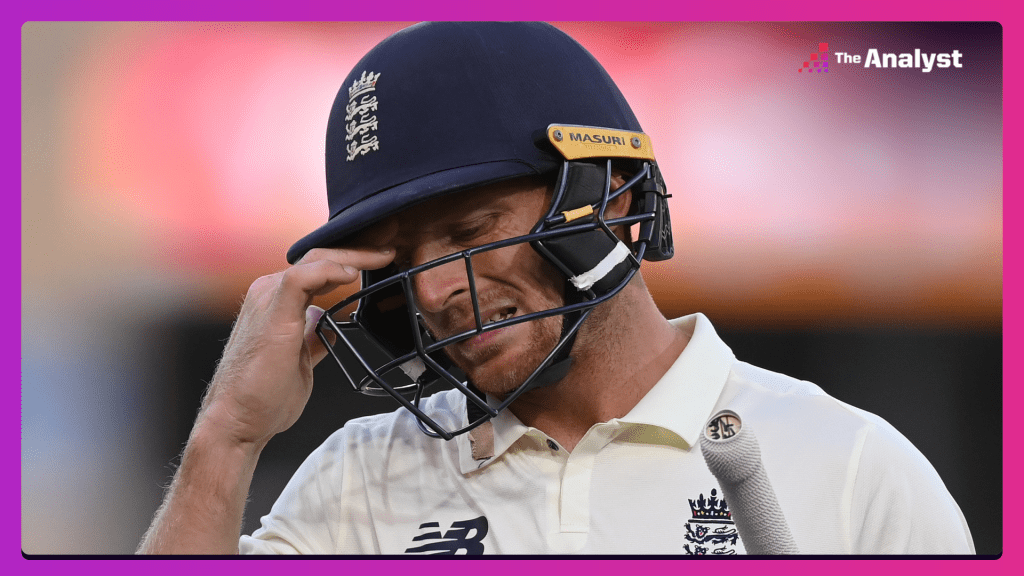
December 19, Day 4
Australia 230-9 dec // England 82-4
England came out all guns blazing this morning. In a crazy first hour, the tourists took three wickets for 10 runs with the action relentless.
Steve Smith’s innings typified the frenetic start. Before England had him out for six, they could have got him for a first-ball duck after Jos Buttler dropped another simple catch, and then a second-ball duck after he closely survived an LBW shout.
Now, he did score 93 in the first innings of this Test, but there are signs that Smith has not been quite as immortal as in the 2019 Ashes, where he tortured the England bowling attack. He’s had a batting false shot percentage above 20% in each of the first two Tests in this series, as many times as in his 26 Test matches prior to this game.
It was an early session of two halves. England took three wickets in the first 14 overs. Then Australia went 75-0 in the next 13. The difference between the two was the lengths that the English bowlers bowled, with the attack bowling far too short in the second half of the first session. Travis Head and Marnus Labuschagne took full advantage.
The 89-run partnership between the pair took the game well and truly out of England’s reach. Head in particular has been very aggressive so far in the series, counter-attacking well on his arrival to the crease. His strike rate of 92.85 is the highest of any batter to have faced 50+ balls.
From there, the Australian tail thrashed, looking to quickly build the lead before the inevitable declaration came. Dawid Malan picked up his first and second Test match wickets with some part-time leg spin, but you suspect those will not linger for long in the memory.
And so, England now had to bat more than four sessions to save a draw.
They managed 11 balls before losing their first wicket, with Haseeb Hameed caught behind off Jhye Richardson.
Rory Burns scratched around for 34, but he has not looked comfortable at all. He too, has had a batting false shot percentage above 25% in each of the first two Tests of this series, as many times as in the 19 Test matches prior to this game.
Again, England’s hopes of salvaging a draw rested squarely on the shoulders of their captain. Root, visibly in pain after being hit in the abdomen before the game – and again by Mitchell Starc towards the end of play – battled hard, but was dismissed by Starc in the final over of the day. It was the death knell for England.
Starc has now dismissed Root six times in Test cricket. He’s only removed Jonny Bairstow (8) and Dimuth Karunaratne (8) more often.
Before that, however, Root overtook Sir Alastair Cook for the most runs scored as captain for England in Tests.
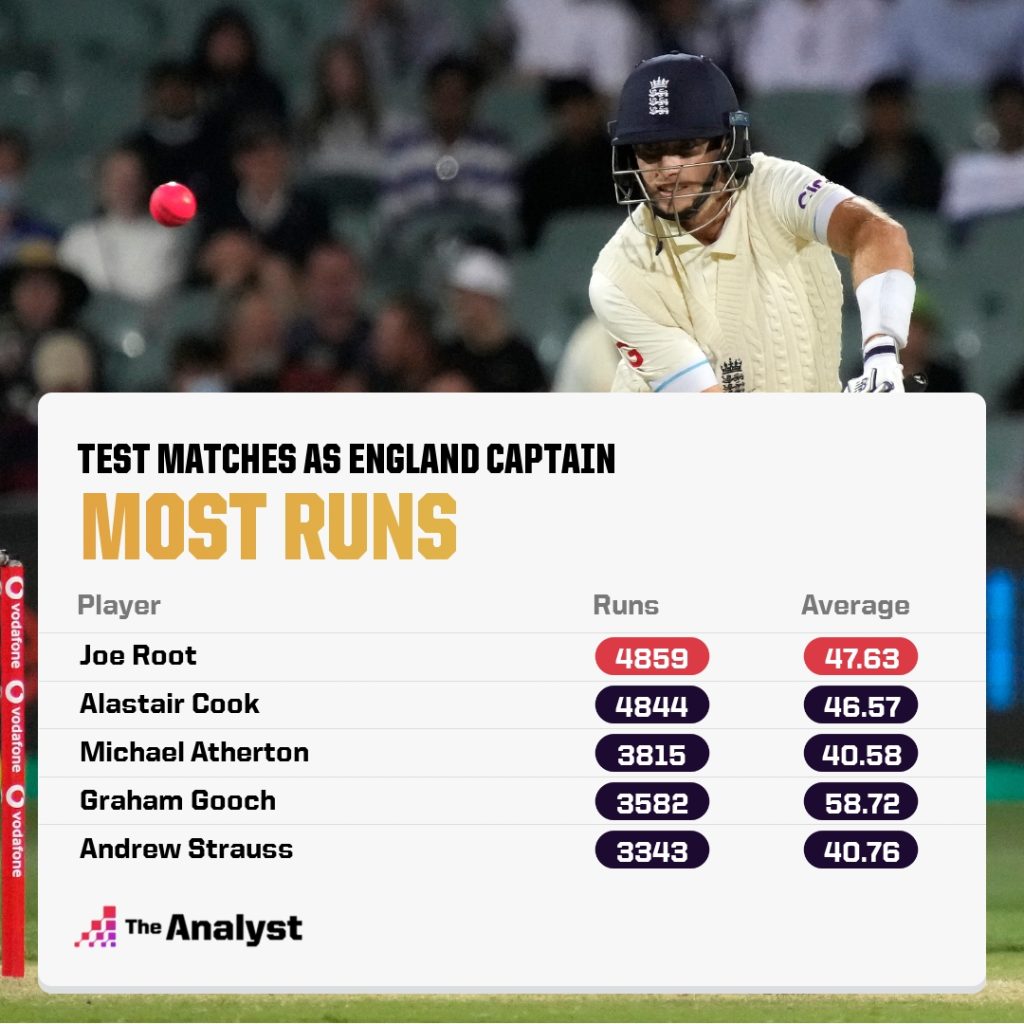
Nathan Lyon will have a big role to play tomorrow. Only once previously has he completed a Test bowling innings at the Adelaide Oval without taking a wicket (November 2019 vs. Pakistan). You suspect that’s a record he won’t add to tomorrow.
His lengths have been immaculate so in the second innings, particularly to left-handers:
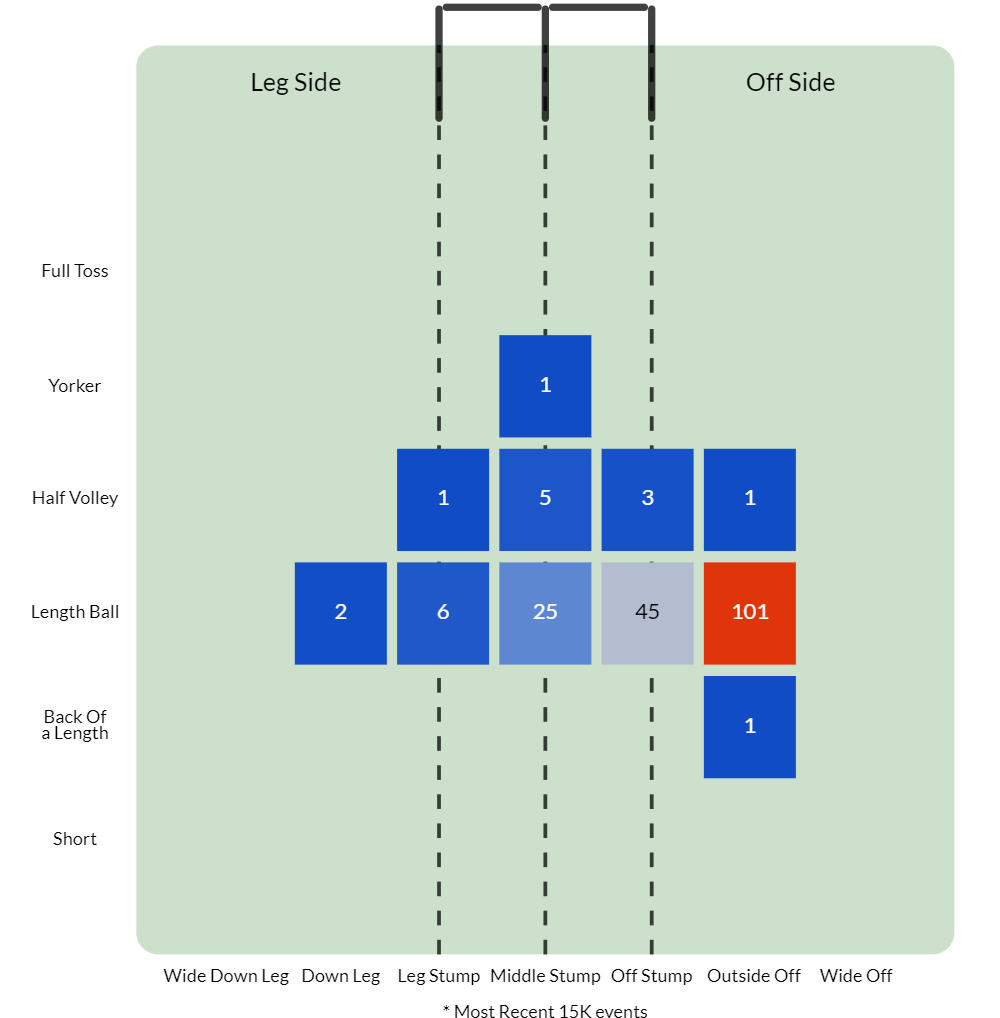
So, England have to bat out the entire day tomorrow with just six wickets left in the bank. It’s basically impossible to see any result other than an Australia win here. Our Live Win Probability model is similarly convinced: Australia (95%), Draw (4%) and England (1%)
December 18, Day 3
England 236 // Australia 45-1
After England resumed on 17-2, the first session started perfectly for England, with Dawid Malan (80) and Joe Root (62) taking England to 140-2 at lunch. It was their second hundred partnership of the series. In truth, the time that England have looked on top in this Ashes series so far is when Malan and Root have been together at the crease. The pair now average 60.9 together, which is the highest average partnership of any England pair since Root’s debut (min. 20 innings together).
Malan in particular seems to thrive against Australia. His Test batting average of 45.9 against Australia is his best against any team he’s faced in the format (next best average of 38.5 against West Indies). After a slow start to his innings, he began to score more fluently:
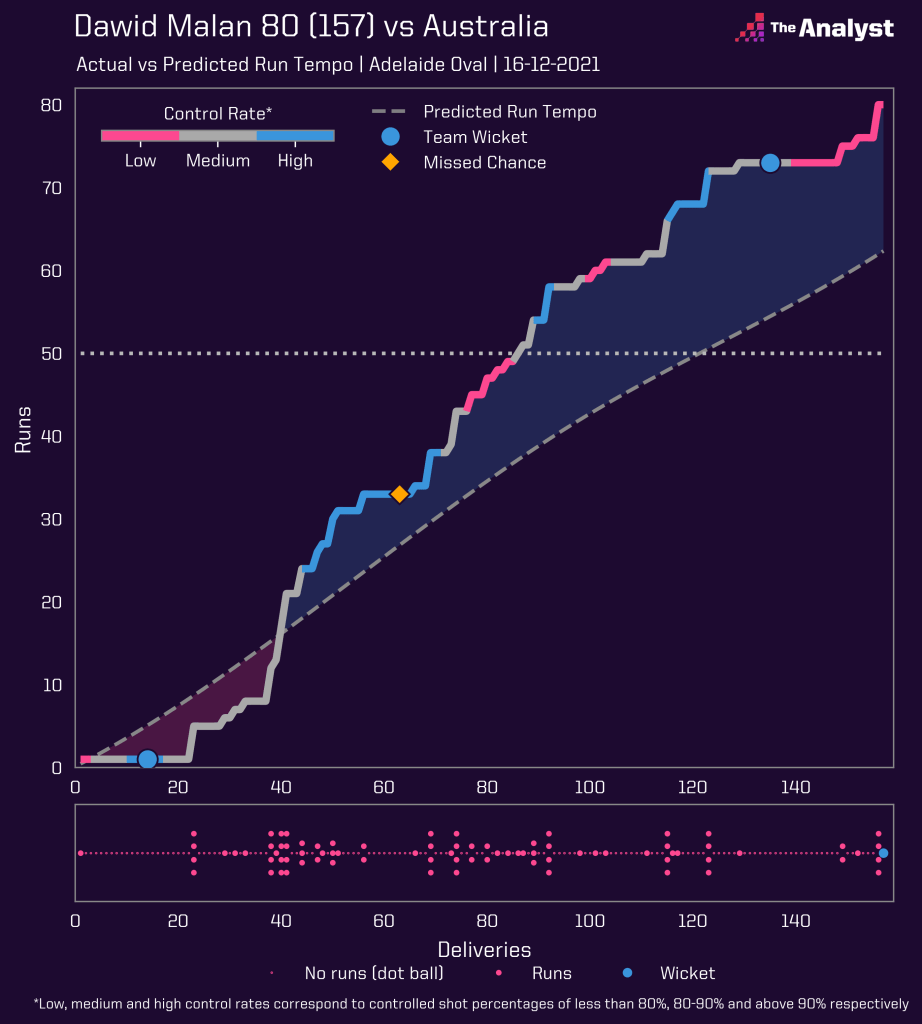
But once Root nicked off to Cameron Green, the inevitable collapse came. 150-2 become 169-6 as England’s middle order faltered. In fact, before Chris Woakes came to the crease England’s innings partnerships read: 7, 5, 138, 7, 7, 5. Woakes and Stokes offered a little resistance, but these were only temporary moments of relief against the Australia onslaught.
James Anderson and Stuart Broad’s partnership of 16 for the last wicket was the joint-third highest of the entire innings. That is not how you win Tests.
Nathan Lyon played another crucial role for Australia’s attack, highlighting the lack of genuine quality spin options in England’s attack. He was consistently able to hold up one end for Australia, bowling with a tight economy rate of 2.1, allowing the quick bowlers a chance for a prolonged rest in the outfield, so that their legs are fresher for their second and third spells.
Lyon really started to get the ball to turn and bounce, particularly as the day went on. Adelaide is Lyon’s favourite home Test venue where he averages 26.5 and has picked up 54 wickets, both highs (5+ matches).
With 4-37, Mitchell Starc claimed his 50th Test scalp in day/night cricket. At an average of 18.1, he is a frightening prospect under the lights. England will certainly have to face him in the evening session of day four and, if they bat really well, again on day five.
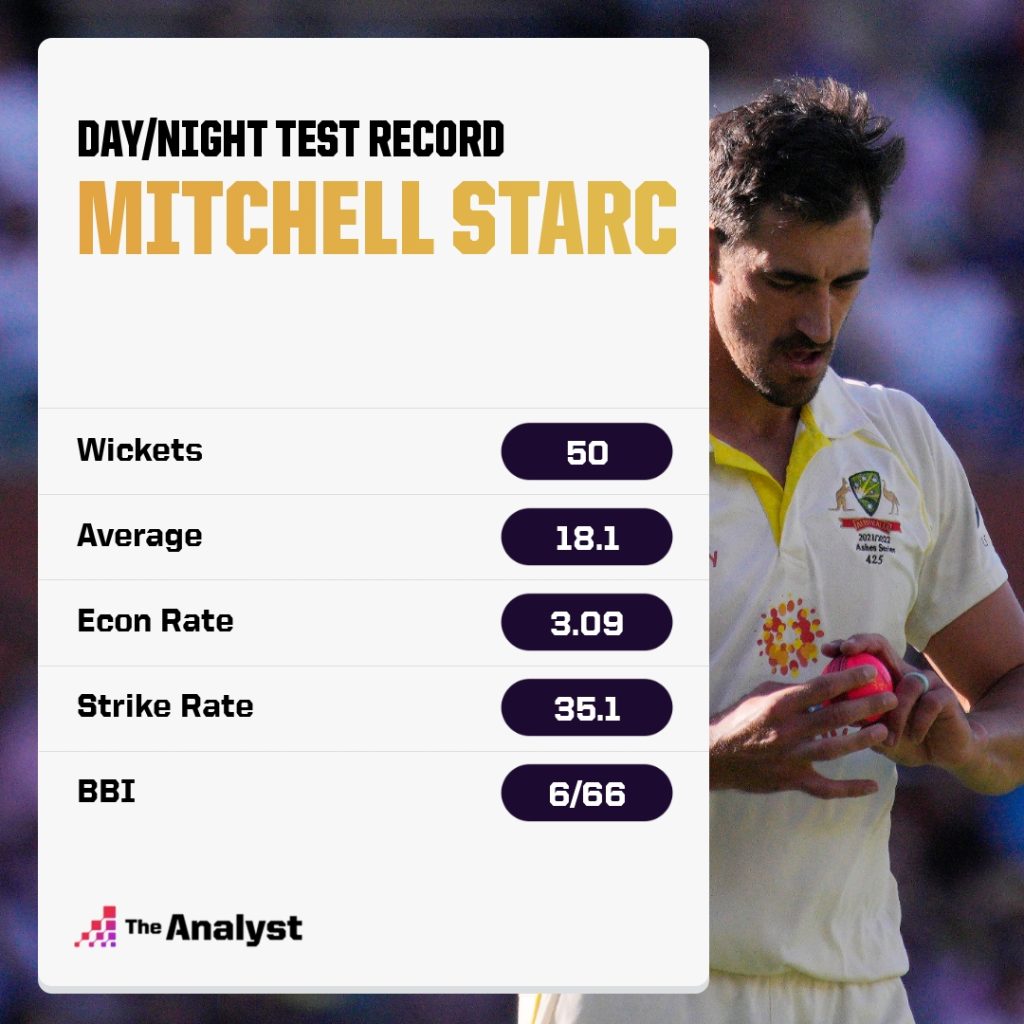
Australia closed on 45-1, with a lead of 282 runs. Despite managing just 13, David Warner is fast closing in on becoming the second-highest scoring Test opener for Australia with 7,474 runs as an opener to his name. He now needs just 52 to surpass Mark Taylor’s total of 7,525.
Marcus Harris has just two Test fifties to his name. Our Score Predictor projects him to make his third tomorrow. It’ll be a much-needed confidence booster for the opener who has struggled big time this series.
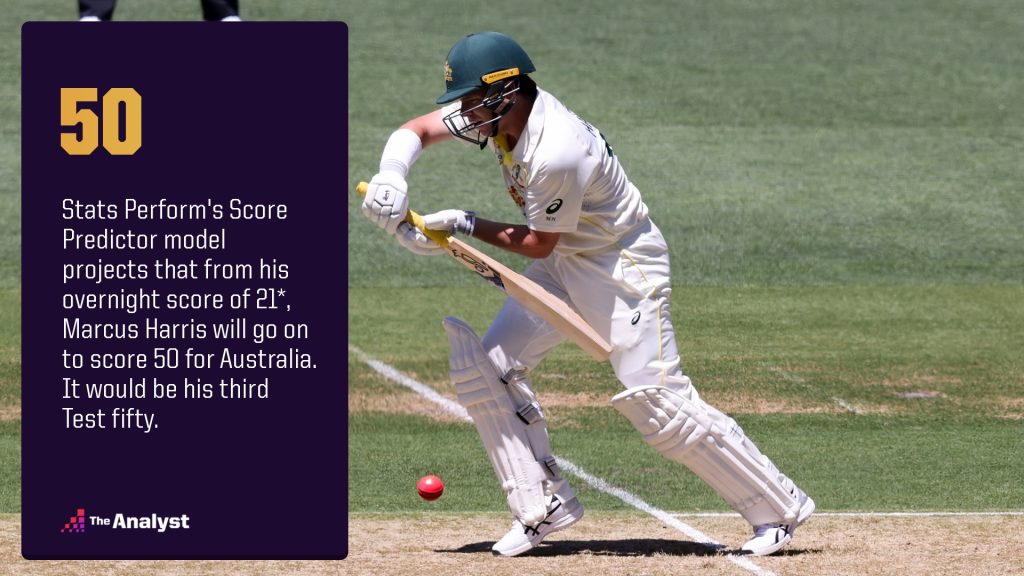
Our Stats Perform Live Win Probability unsurprisingly has Australia as overwhelming favourites to win from here (86% chance), with the draw just 13%.
December 17, Day 2
Australia 473-9 dec // England 17-2
In the end it took an act of nature to stop the punishment in Adelaide, almost as if a giant God had stepped into the ring and said “we’re gonna call it a day folks”. As lightning stopped play on the second day of the second Ashes Test, Australia are on the cusp of knocking a frazzled England out for the count.
Marnus Labuschagne could only add eight runs to his overnight score of 95*, despite England giving him yet another life after Ollie Robinson had him caught behind off a front foot no-ball. Nevertheless, this was Labuschagne’s sixth hundred in just 20 matches and his first against England. Remarkably, he is now averaging 62.5 in Test match cricket for Australia, which is the country’s second-highest Test batting average of all time.
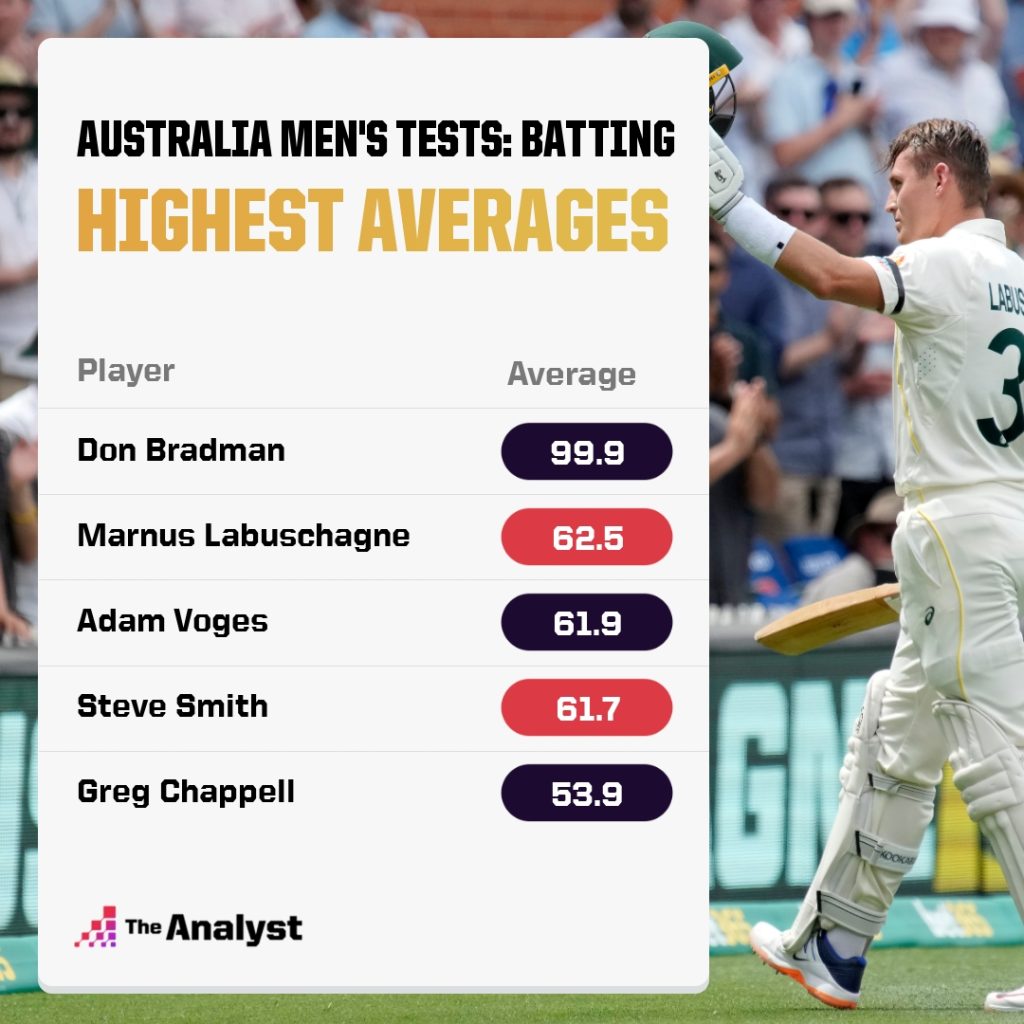
Fourth on that list is Steve Smith, Australia’s fill-in captain for this match. Smith has long been a thorn in England’s side, and he was at it again, infuriating England with his calm and measured accumulation of runs. The worm below shows he played with serious control throughout his knock.
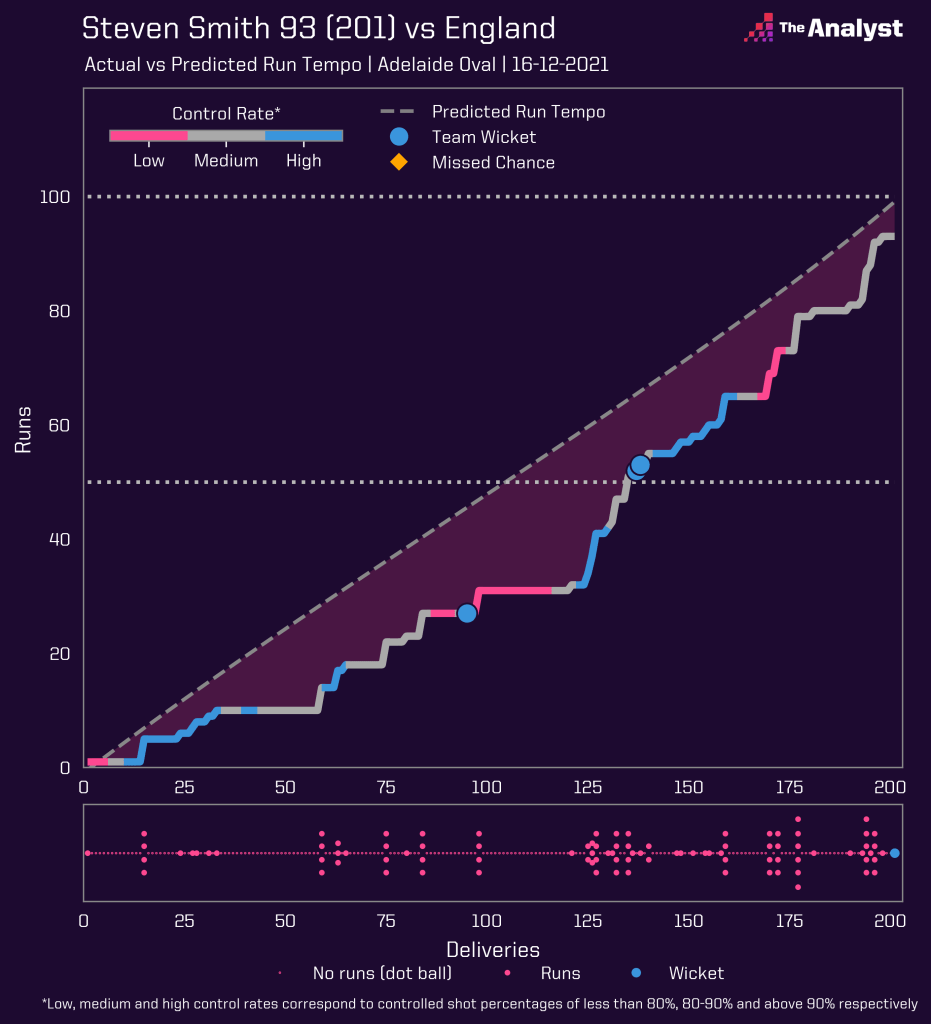
For once he missed a straight ball. For once he didn’t pile on the pain with an Ashes century.
England were inflated with a bit of belief when they got Travis Head and Cameron Green out in consecutive overs with Australia at 294-5. They were in the game, hanging on by their fingernails.
Then Smith and Alex Carey stomped on those fingernails with a 91-run partnership.
Carey had scored 342 runs across his previous five first class innings at the Adelaide Oval at an average of 85.5 prior to this Test match and he looked comfortable at the crease, making a good connection with 65.4% of his shots. For context, Smith’s rate was 55.7%, and Labuschagne’s 51.8%, so Carey was certainly seeing the ball nicely out there.
Michael Neser strode in on debut and proceeded to look like he’d walk into England’s top five. His 35 is the best batting innings on debut by an Australian debuting at #9 since Tony Dodemaide scored 50 runs against New Zealand in the 1987 Boxing Day Test. Given the scoreboard situation, he clearly had the license to attack, playing an attacking stroke on 62.5% of his deliveries faced, the most of any Aussie batter.
England toiled hard in the field but were ineffective. Chris Woakes looked particularly harmless and his economy rate of 4.35 is the most expensive he’s ever been in a Test match where he’s bowled 20+ overs.
In the evening session, Australia were menacing. Mitchell Starc, the world’s leading day/night wicket-taker was at it again and produced a sharp delivery that Rory Burns fenced to second slip. Starc has taken 47 wickets in day/night Tests and is just three shy of becoming the first player to reach 50 in the hybrid format. No other player has taken more than 32 wickets in day/night cricket.
England’s hopes (if you could even call them that) rest on Joe Root and Dawid Malan. The pair batted well together in the first Test. In fact, that partnership was probably the only period of the two Tests so far where England have been on top.
Our Stats Perform Score Predictor is more realistic on England’s chances of success though. It estimates that England will go on to score 220, with Root top-scoring on 43. That’ll see them face a 253-run deficit.
Sounds about right.
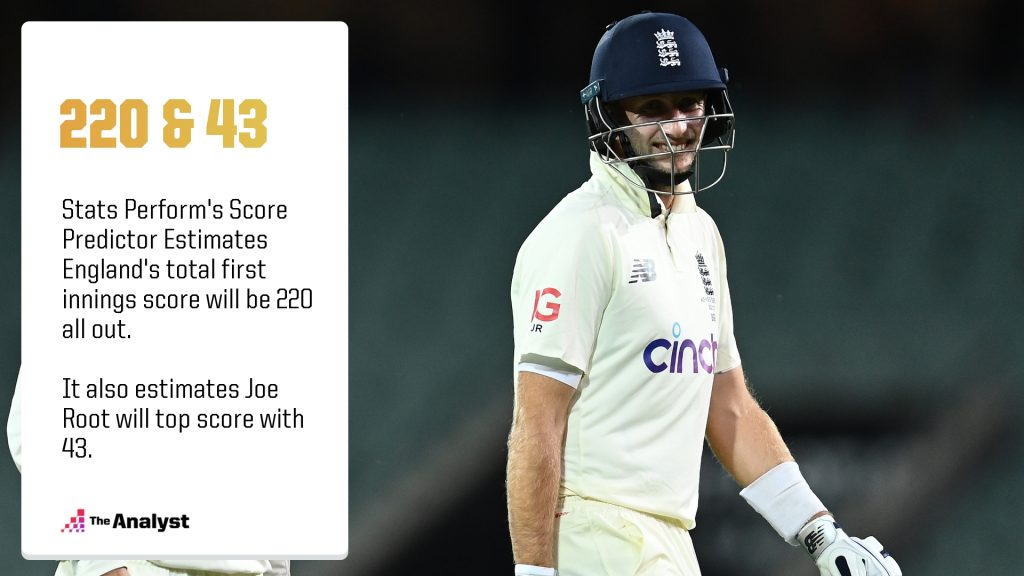
December 16, Day 1
Australia 221-2
We’re at stumps on Day 1 at Adelaide and it’s England toiling as Australia cash in on some of the tourists’ errors. Where have we heard that before?
Jos Buttler’s drop in the dying moments of the day, an inexplicable lapse of concentration that gave Marnus Labuschagne his second life of the day, rather summed England’s tour so far: melancholy, despondent and lacking in application.
At the start of the day’s play after the toss, Stats Perform’s Live Win Probability had Australia as favourites to win the Test at 63.7%, with England at 26.5% and the draw at 9.8%. More on how that model works below.
Now after a long day in the field for the visitors, the probabilities have further shifted in Australia’s favour:
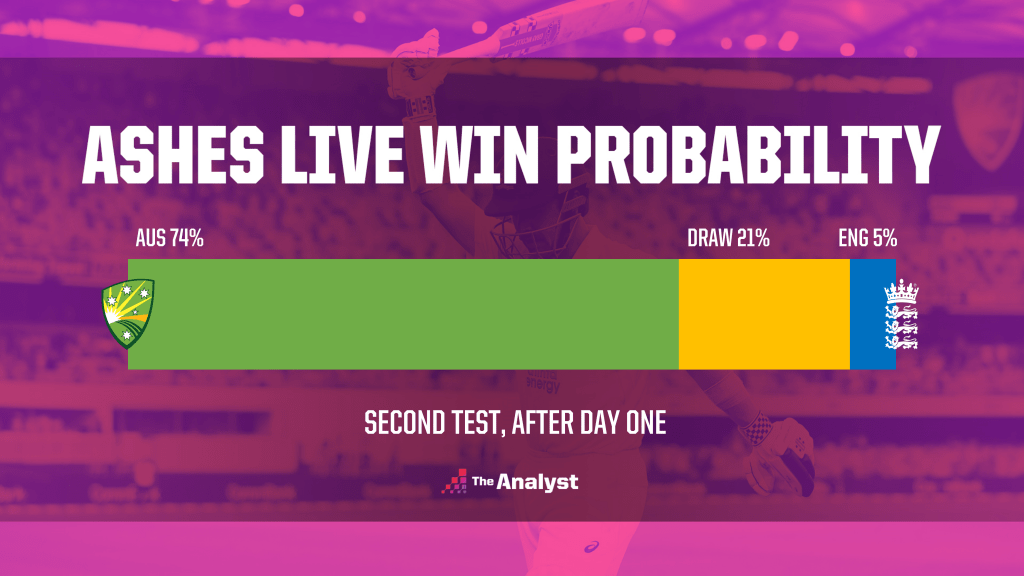
It was an attritional first session, with David Warner and Labuschagne digging in after the early loss of Marcus Harris. For Harris, it was another failure to impress, after Stuart Broad had him caught behind for 3, with Buttler springing to his right to take a super catch. It only made his drop later in the day even more baffling.
Harris has really failed to get going in his Test career since debuting in 2018, with an overall batting average of just 22.2. If that sounds low, it’s because it is: his average is the seventh lowest of any top order batter (1-7) for Australia in men’s Tests.
It gets worse when looking at his stats in Ashes Tests, where the opener is averaging just 9.1 across nine innings.
At the other end, it was an uncharacteristically slow start from Warner who scored nine from his first 50 balls as England bowled tightly. The first 16 overs resulted in 10 maidens.
But once Warner and Labuschagne had rode the initial England storm, things got easier and runs started to flow, with Warner now registering back-to-back fifties against England in Tests after logging just one in his 11 innings before that. It’s taken just two innings for the opener to better his 2019 Ashes tally.
Together, Warner and Labuschagne continued to pile on the runs. The pair love batting together, boasting a Test batting partnership average of over a hundred (101.8), the third-highest of any Australian combination to have batted at least 10 innings together in the men’s edition.
Labuschagne continues to be a run machine. Since his test debut in October 2018, only Joe Root has scored more runs than him, and he’s reached the 2,000 Test run mark in just his 20th match.
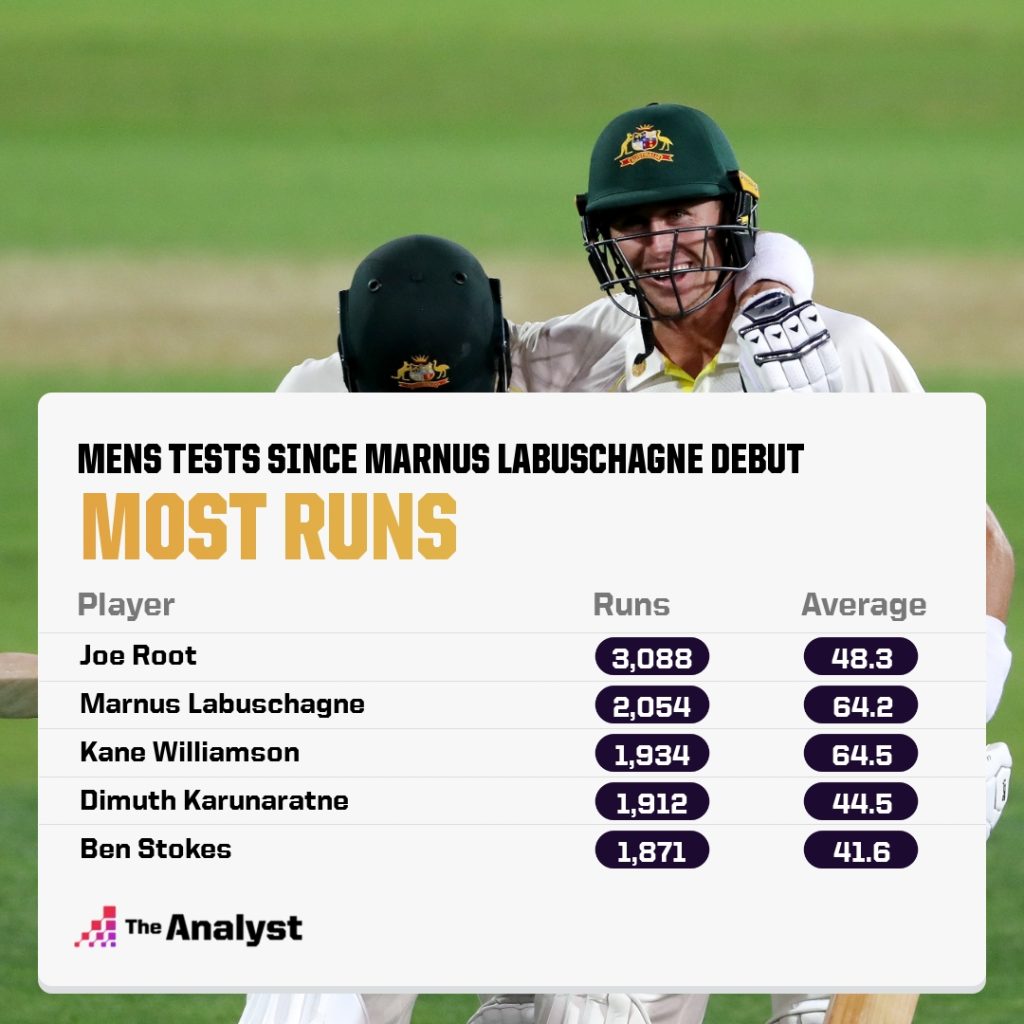
Presumably England picked five seamers and left out spinner Jack Leach to make the most of the pink ball and the favourable bowling conditions under the lights. That’s why it was all the more confusing that their lengths were consistently too short for much of the day. At some points England clearly had a plan to hit Australia with some targeted short-pitched bowling, but other than getting Labuschagne in a tangle at times, it didn’t look too troubling. Besides, if this was going to be the tactic then why not pick Mark Wood?
England’s lengths show this. They bowled 27.3% of their balls back of a length today, compared to just 23.7% in the first Test. Ben Stokes, in particular, was asked to run in hard and bowl the ball into the pitch. Almost 70% of his deliveries today were back of a length, compared to his 44% average across Tests in 2021.
Australia, who’s quick bowlers constantly threatened in Brisbane, bowled just 18.4% of their balls back of a length. Is that telling?
Dropping Labuschagne on 21 has already hurt England. Dropping him again on 95 could be match-losing, with Stats Perform’s Score Predictor telling us we expect him to go on to score a huge 153.
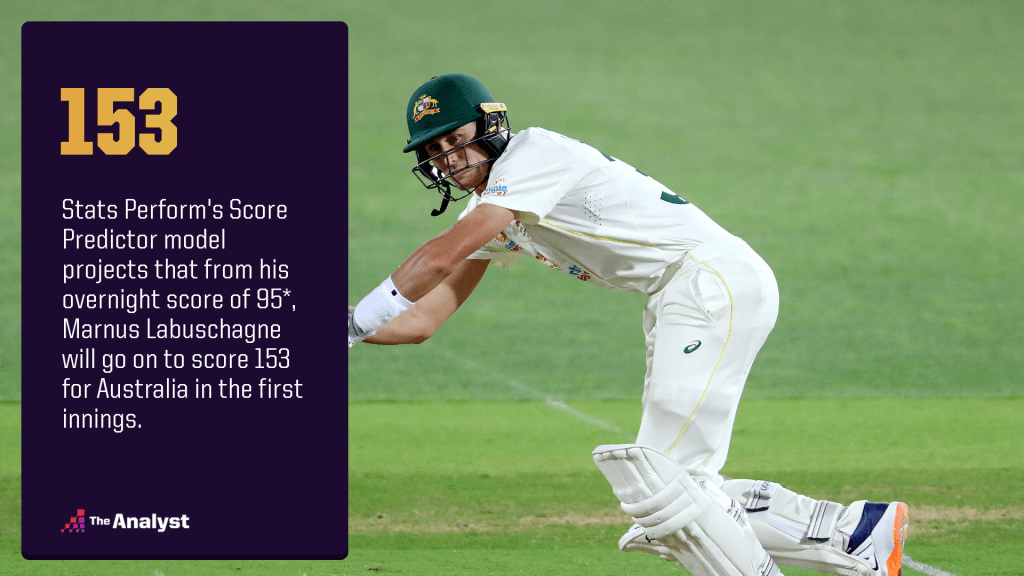
The Stats Perform Live Win Probability model uses our Match Simulator to simulate the remainder of the match 1,000s of times.
- Our Match Simulator simulates ball by ball to the end of the match.
- Ball by ball predictions are powered by our Next Ball Predictor model, powered by Quinn, which predicts the probability of each delivery outcome using several contextual match factors, including:
- The match score
- Venue information
- The historical performances of both the batter and bowler
December 15, Pre-Test
Bris-pain
For England fans, the 2021-22 Ashes Series got off to a predictably painful start. The first test at the Gabba – colloquially named the Gabbatoir (for obvious reasons) – ended in a heavy, nine-wicket defeat, as England got off to their customary 0-1 start. England’s record is notoriously poor at the Gabba, having won just two Test matches at the ground since the end of World War II.
But with that result in the rear-view mirror, we look ahead to the Adelaide Oval and the second Test match in the series. Surely the tealeaves show slightly more positive signs for Joe Root’s men?
Er, well. Let’s see. Here are five things to look out for as we enter the first day/night Test of the series.
Bucking the Trend?
History isn’t exactly on England’s side here. Australia have won five of their last six men’s Tests against England at the Adelaide Oval, including each of their last two. Their only defeat in that span was an innings & 71-run loss in December 2010, as part of England’s 2010-11 Ashes triumph.
England’s record at Adelaide is a snapshot of their wider woes Down Under. England are winless in their last 11 men’s Tests in Australia (D1, L10). Only once have they recorded a longer winless run in the country (12 matches – D2, L10 from January 1937 to February 1951).
Things look bleak right now for the tourists…
Night and Day
The second Test is the first of two day/night Tests in this series, with the fifth and final Test match also under the floodlights in Hobart.
And each side’s record in this format of Test cricket is, well, night and day. Let’s start with Australia, the early kings of the pink-ball era. They have won all eight of their day/night men’s Test matches, the most by any side and the only team with a 100% winning record. England have lost each of their last three games in this format, after winning their only fixture prior (August 2017 vs. West Indies).
We probably would have seen the return of one or both of Stuart Broad and James Anderson regardless of what conditions this game was played under, but with the pink ball swinging under the lights it’s something that seems inevitable. Anderson took 5-48 in the dusk at this venue three years ago, while Broad caused Australia’s left-handed batters all sorts of issues in the 2019 Ashes with his around-the-wicket bowling.
David Warner’s troubles against Broad made the headlines for obvious reasons, but Travis Head also fell three times to him in that 2019 series. Unfortunately for England, both enter Adelaide in fine form, particularly Head who made 152 in Brisbane, the third-fastest Ashes century in history. Head was particular prolific driving the ball, scoring 49 of his runs through that method (32%).
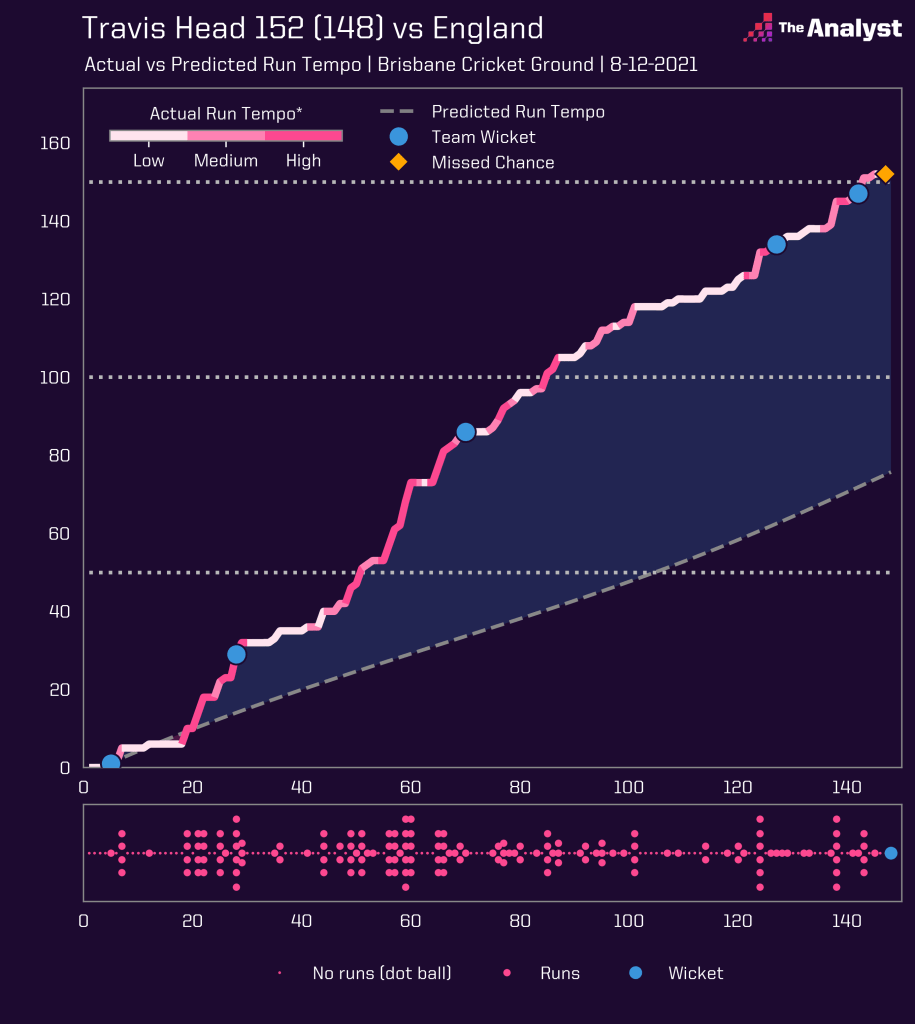
England’s decision to go without either of their two senior bowlers for the first Test looks even more conspicuous after the fact. Since Broad made his debut in December 2007, England have never won a Test match in which both he and Anderson were absent (D2 L3).
Josh Hazel-Won’t
Josh Hazlewood is unavailable for this Test match due to the side injury he picked up at the Gabba. Jhye Richardson will fill in for him.
Despite Richardson’s impressive performances in the Sheffield Shield in 2021-22, where he claimed 23 wickets at 13.4, England will undoubtedly be relieved to see the back of Hazlewood.
In five pink-ball Tests at Adelaide, Hazlewood has 28 wickets at 18.4 apiece. So too does Mitchell Starc, with his 28 wickets coming at an average of 17.6. The duo are a fearsome day/night combo and are the top two all-time leading wicket takers in day/night contests (Starc on 46 and Hazlewood on 32).
As well as his fine record against Joe Root, Hazlewood brings extreme control over his line and length, and a great ability to build immense pressure on opposition batsmen. All while hurling the ball down at speeds nearing 90mph.
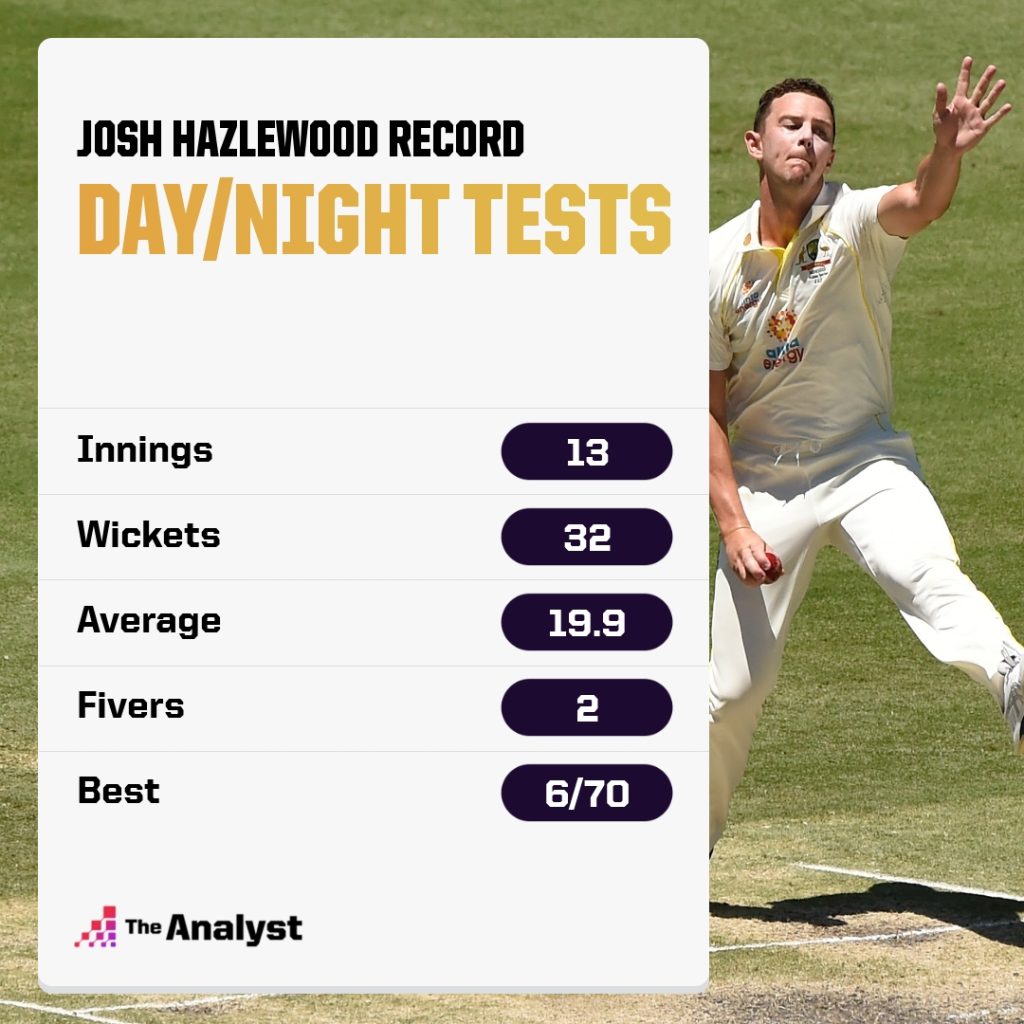
Australia missing at least one of that deadly pair will be a blessing for England’s fragile batting lineup.
Root or Bust?
Once again, all eyes will be on Joe Root as England’s main run-getter. With the current state of the batting lineup, you feel it’s almost impossible for England to win unless Root goes big himself.
The England skipper has been in absurdly good form in 2021. His run tally for the year with two Tests remaining stands at 1,544, and Pakistan’s Mohammad Yousuf’s calendar-year record of 1,788 is well within reach.
But Root’s class only serves to highlight England’s deficiencies in the batting department.
Of the 24 players other than Root who have played Tests for England in 2021, only one averages more than 30: Dawid Malan (38.8). For comparison, Root’s averaging 64.3 in 2021.
The skipper will need some help if England are to get back into the series.
Leach to Get the Treatment Again?
Left-arm spinner Jack Leach has been named in the 12-man squad despite the punishment dished out to him in the first Test last week. Keeping Leach in the 12 is a show of faith after he was smacked all over in Brisbane, conceding 102 from 13 overs. His first innings figures do not make for pretty reading, and in fact rank fifth for the most expensive spell in Test history (min 10+ overs).
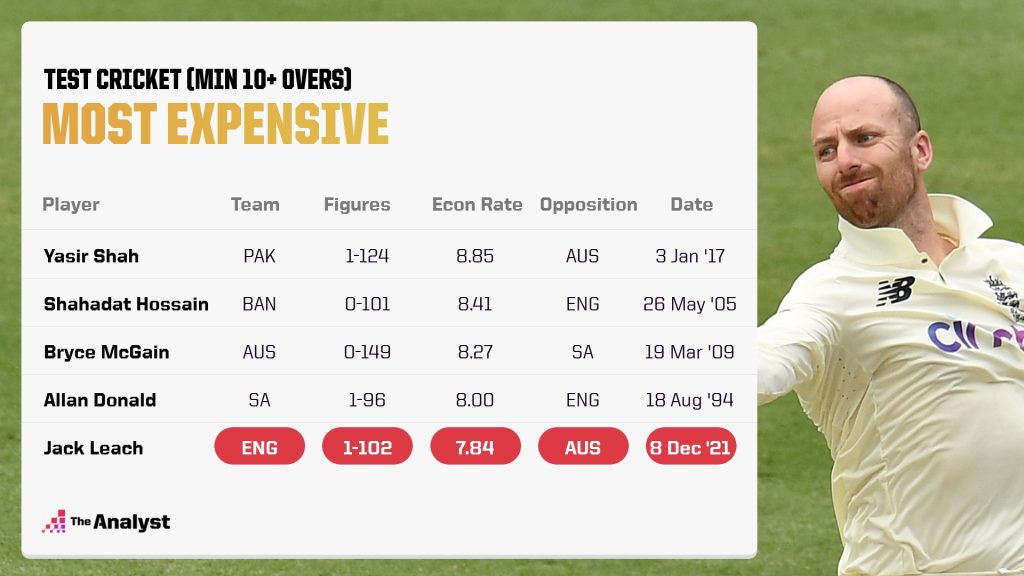
The Aussie batters did not let Leach settle at all and looked to attack him straight down the ground at every opportunity.
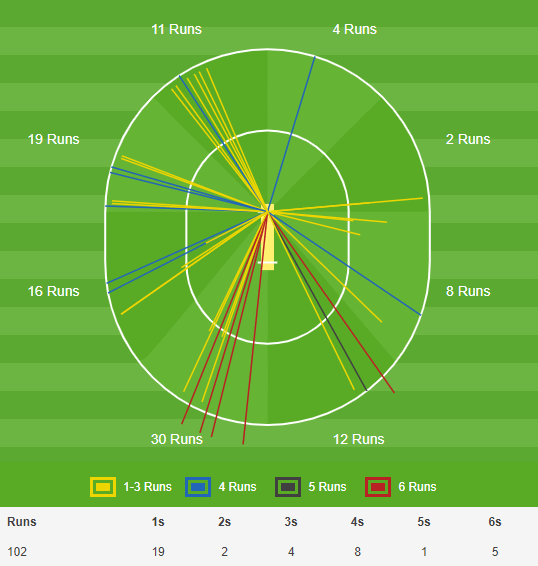
It seems England’s last spot in their starting XI will be handed to either Chris Woakes, Stuart Broad or Leach. Leach adds balance, and England have been warned against going into the Test without a spinner by Adelaide Oval groundsman Damian Hough. If selected, he’ll need to respond strongly to the hammering he took in the first Test.
Enjoy this? Subscribe to our mailing list to receive exclusive weekly content.
Design by Matt Sisneros.
